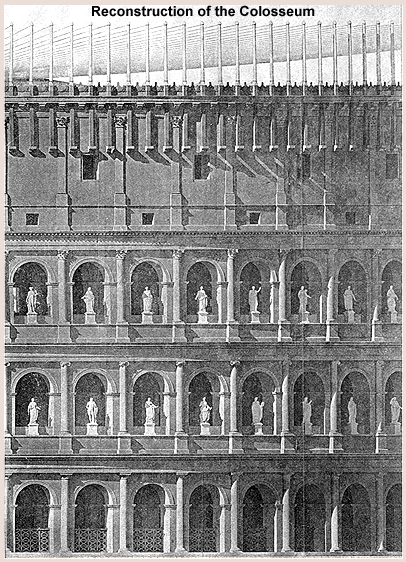Arcades
Definition of Arcade
In architectural construction, an arcade is a level, continuous series of arches, whose depths are less than their spans.
Efficiency of Arcading
Because individual arches exert lateral pressure, using them in a series is structurally efficient so that they can brace each other, much as the voussoirs of an individual arch brace each other.
SUPPORTS CARRYING ARCADES
Overview
Arcades are usually elevated by supports, and over the centuries, two types of supports have been used to carry them: piers and columns.
Piers
In Roman architecture, piers were the standard form of support for arcades. When used for important public buildings, arcades were usually ornamented by decorative columns carrying entablatures as can be seen at the Theater of Marcellus.
Columns
Columns were not used for supporting arcades until late in Roman history. The use of arches over columns at Diocletian's Palace in Split, Croatia, exemplifies a late Roman inventiveness in creating new combinations of forms.
Post-Roman Uses of Piers and Columns
Supporting arcades by columns instead of piers was common in Early Christian and Byzantine architecture.
Piers were important in Europe in the Romanesque and Gothic periods, when an increase in church height called for an increase in support size.
In the Renaissance, the use of classically derived columns for arcades was introduced by Brunelleschi in 1419 at the Foundling Hospital in Florence.
Piers to support arches were re-introduced at the end of the fifteenth century in Rome for the Benediction Loggia, the courtyard of the Palazzo Venezia, and the entrance loggia of its church, San Marco. By the sixteenth century, their use was common as exemplified by the courtyard of the Palazzo Farnese.
Bridges, Aqueducts, and Triumphal Arches
In Roman times, miles of arcading were built as aqueducts and bridges. Three-arch structures were built as triumphal arches.
Supportive Open Partitions
When used internally to help support the roof, arcades formed open partitions like those between the nave and side aisles of vaulted Roman basilicas.
Outer-Wall Construction
Solid outer walls may be formed of arcades whose openings are filled by a lighter, less valuable material than the stone or brick forming the voussoirs.
The open arcades forming the outer walls of arcuated construction are the front facings of lines of vaults.




 Add Placemark
Add Placemark Go Back
Go Back 




